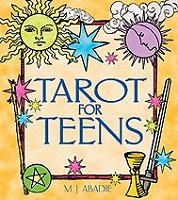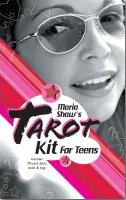|
Tarot Reflections |
December 15 , 2004 |
| Teen Tarot Reviews Sandra Thomson, CTGM |
||||
|
Let me say at the outset that I don't read for teens because the kind of Tarot readings and work I do involves deep exploration of unconscious and shadow material. Teens have other needs and developmental tasks than shadow work. However, since I do teach Tarot, I felt compelled to comment on some of the good and some of very poor aspects of two 2004 publications now on the market to help teens understand the Tarot, and with respect to teaching teens to be good readers when they do get ready for adult work. I receive many review copies of books and decks, so it is usually my policy to write about books and decks where I can write primarily positive things. Since I purchased both of these publications, I feel free, in this case, to be able to comment on their merits or lack thereof. M. J. Abadie's 245-page book is the far more complete and thoughtful book, scattered with inspirational quotes from people like Joseph Campbell, Albert Einstein, Jungian analysts Erich Neumann and Edward Whitmont, Immanuel Kant, and others. Heady stuff. Although Abadie describes herself as a "tarot master," it is not clear what she means by that. Is she certified? Or is it a self-attribution used to give herself more credibility? The idea of certification down the line is never mentioned in either book. The cover of Abadie's book identifies her as a professional tarot reader, astrologer, and psychotherapist, who did mythological research with Joseph Campbell. The cover of Shaw's book describes her as a professional astrologer, intuitive, tarot expert, and the astrologer for the TV Guide Channel. There is no doubt about the credibility of Abadie's knowledge, whether certified or not. She gives good advice when she writes that the primary purpose of the Tarot is to tap into inner wisdom and that it can give teens a "big-picture snapshot" of their lives by answering pertinent questions about specific concerns. While she writes that it should not be used to predict the future, and does give some general questions, she, nevertheless, gives these examples of appropriate teen issues for which to ask questions: "Is State the best place for me to go?" "Will I be happiest at State?" "Is State the place where my degree will earn me the kind of job or career I want?" Or, for social issues, "Will I have a good time with xxxxxxx?" "Will being a member of [xxx club] benefit me?" Typical spreads include yes/no, three-, five-, and seven-card spreads, and a horoscope spread. Which spread do you think a teen will use for the preceding questions? Shaw gets into even more trouble here, inasmuch as she suggests teens start off with yes/no readings and gives examples of appropriate specific questions as, "Will I be dating someone this year? "Will I pass my science test?" Will I make a new best friend?" If you don't understand the answer, draw a second card for clarification. Oh, my. In Shaw's "I Think I'm In Love" spread, the third position asks the question "How does he or she really feel about you? Is your sweetie head over heels in love, or is he or she fickle?" Never does she explain that this is unethical — or for that fact, even bring up the idea of ethics in tarot readings (neither author does) — and that when you ask questions like this, they refer to your own projection rather than actual fact about "the other." Does she even know this? Here Shaw's is definitely the more problematic book. Both books include the Celtic Cross spread, I suppose for completeness, but to my mind it is the absolute worst spread to present to a beginner of any age. Not only does Shaw's advice purport to help teens answer specific questions, she also tells them how to determine the timing of the answers, further emphasizing the erroneous fortune-telling aspect of the tarot. "When" questions (When will we meet? When will I get a job?) are answered by the aces, which represent the seasons, and by the astrological time period associated with the court cards. Major Arcana simply answer "very soon." Pity the poor teen who draws a pip card for a "when" question. "What do I do now?" he or she must ask. Alas, there is no answer. Shaw also suggests that the teen create a "learner's deck" by writing the upright meanings on the top of the cards of one deck and the reversed meaning on the bottom of the cards. I had an adult student who once came to my classes with just such a deck, and it took him a very long time to attend to the symbolism and scenes on the cards and, thereby, to consider and develop more expanded ways of reading the cards instead of simply applying his "cue" words. I believe he was crippled for a long time by this deck, which he finally gave up, and, to his credit, has become a very creative and sensitive reader. Both books have their own definitions of the cards, Abadie using the Rider-Waite-Smith deck, and Shaw using Lo Scarabeo's Universal Tarot, which comes in the kit with its own black gossamer bag. For the most part, they are in line with some of the more common understandings of RWS-type cards. Most problematic, however, are the definitions applied to the court cards. While Abadie defines the court cards as representing facets of one's own personality, qualities one is trying to develop, a current sense of identity and specific people in your life, when then defining the court cards, both Abadie and Shaw seem to lean more heavily on the "specific people" category. Shaw writes regarding the Page of Cups: "When you draw this card, expect a very special person to come into your life." Abadie says he represents "a young person who is bringing you a message about love." Shaw's Page of Swords tells the teen that "someone is spreading lies to manipulate you and your friends. . .Malicious rumors are everywhere. There may be someone spying on you too." I shared this meaning with a Tarotist who has a 13-year-old daughter, and she, like I, was dismayed. She responded, only somewhat tongue-in-cheek, "I know my daughter would go overboard if she ever got a reading like that. Given the suspicion and paranoia that naturally occurs with teenagers who are going through a very fragile time of life, is it responsible to tell them that turning over a card means that now they must conduct an Inquisition of their friends to find out who the traitor is, and then, eject him or her from their lives? On a more positive level, Abadie suggests the Page of Swords may represent a "younger sibling or other child whom you are helping to develop mental capacity." She writes the card is also about taking mental risks and experimenting with some new line of thought. When Abadie begins to discuss the Minor Arcana she redefines them in terms of teen-age energy, and it is probably one of the more original parts of her book. She writes, for instance, "Teenagers express Wands energy. . .through making plans for future work, actually having a part-time job, interacting with people outside the framework of home and school, going on outdoors adventures, and taking on creative projects either for school or in the family." With regard to Swords, Abadie says that teens are almost always confronted with issues of power and express the energy of Swords when they are involved in defending their ideas or their personal space. "The appearance of Swords often means worry, trying to solve problems. . .feeling lonely or abandoned, deprived or left out, coping with loss or heartache." Pentacles speak teen issues such as "pressure to focus on studies and get good grades." They also suggest issues around money and how to get more of it, as well as all the questions of physical life that teens are exploring at this time in their lives. Abadie says Cups often turn up in teen readings since they are "usually in a state of some sort of emotional arousal. . .[and reflect issues around] good food, a comfortable environment, social pleasures, emotional peace, small blessings." Although she does indicate that Cups describe unconscious processes, and that teens are in the process of having their unconscious awakened, "with cups, the emphasis is always on expressions of love and your inner life." While I think Abadie's thoughts about awaking the unconscious are important, I doubt teens will understand much what she is talking about, so I suspect that teens will interpret this as "inner life" refers primarily to love or romance, which even some adult Tarot readers seem to think is the primary focus of Cups. Abadie includes sections on color and numerical symbolism (Shaw also writes re numbers), rituals for storing and clearing cards, and the astrological correspondences and key astrological characteristics of the Major Arcana. Shaw's book gives instructions for making your own Tarot bag. Clearly, Abadie's is the more well-advised and complete book, although there is lots of duplication, which would have been helped by some good editing. She twice explains the structure of the tarot. Then with regard to the Major Arcana, there is a chapter on The Fool's Journey, plus a lengthy chapter on the Major Arcana and their meanings, then another lengthy section on the upright and reversed meanings of the trumps. So, you have to look several places to get the full understanding of the majors. Pity. In fairness, I have to say that I made this same mistake once, but fortunately, I had a superb and discerning editor. Ultimately, and in their own way, each of these books suggests to the teen reader that the tarot should not be the final word or authority, but I worry about how many impressionable teens will get that point. I think the ultimate tarot teaching for teens still awaits. Tarot for Teens (ISBN 089281917-0) is published by Bindu Books in Rochester, Vermont. Maria Shaw's Tarot Kit for Teens (ISBN 0-7387-0523-3) is published by Llewellyn Worldwide. |
|||
|
|
||||
|
Subscribe to Tarot Reflections, and receive notification of each update! |
|
Request to be added to the list by sending email to TarotReflections-subscribe@yahoogroups.com! |
All articles remain the
property of their respective authors.
Tarot Reflections is a publication of the American Tarot Association
- Copyright (C) 2004
Questions or Comments? Contact Us.



